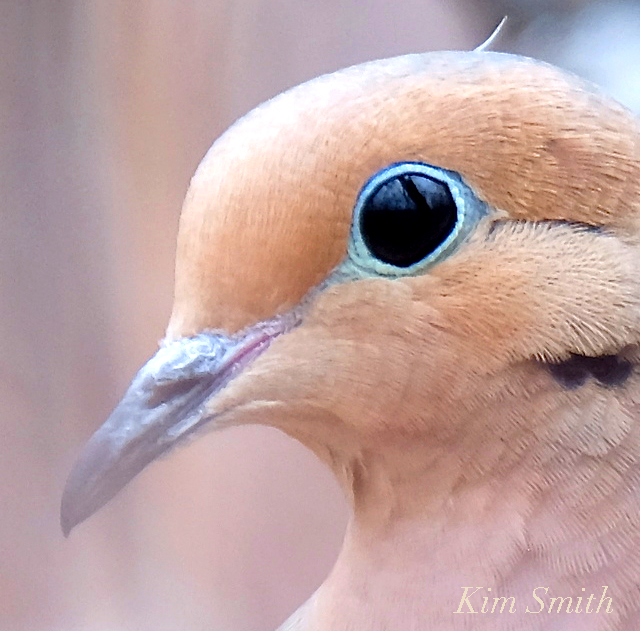 Beautiful Mourning Doves hanging out in the semi-frozen bird bath wondering too if the temperatures are ever going to warm.
Beautiful Mourning Doves hanging out in the semi-frozen bird bath wondering too if the temperatures are ever going to warm.
Tag: Zenaida macroura
PEARLY PINK MOURNING DOVE EGG
Working today from my home office and I was so delighted to hear the Mourning Doves cooing. There has been a great deal of dove activity on our porch lately, and a bunch of half-built nests. One sat on our mail table for the longest time this morning. Look what she left behind! I hope the pair of Mourning Doves returns to incubate the egg. Time to make a temporary mail bin 🙂
LOVE BIRDS!
I’ve been keeping my eye on this pair of Mourning Doves and early this morning I found their nest! They saw me filming and photographing them and flew away. I hope they don’t abandon the nest as it would be wonderful to film the babies (squabs).
 The male approaches the female with bobbing head and puffed chest, inviting her to a nesting site.
The male approaches the female with bobbing head and puffed chest, inviting her to a nesting site.
 Female Mourning Doves build the nest.
Female Mourning Doves build the nest.
 The male dove carries the nest building material to the female.
The male dove carries the nest building material to the female.
 A loose collection of twigs, pine cone needles, and grass, the nest is usually sited in a tree.
A loose collection of twigs, pine cone needles, and grass, the nest is usually sited in a tree.
 I hope I can find the nest again! Keeping my fingers crossed the pair will still be there when the rain lets up.
I hope I can find the nest again! Keeping my fingers crossed the pair will still be there when the rain lets up.
I love that you can see a nearby tree reflected in the dove’s eye. This is the above photo of the female Mourning Dove, super cropped.
Birds of Cape Ann: Mourning Doves and Why Birds Fluff When Cold
 Pair of Mourning Doves in Pear Tree
Pair of Mourning Doves in Pear Tree
While writing this post and listening to recorded songs of Mourning Doves, I was immediately transported to my grandparent’s summer cottage on Cape Cod. Their home was sited on a bluff overlooking Cape Cod Bay. Adjacent to the house was a tumbled and scrubby overgrown field and, only a sort walk down down the lane, the freshwater Hiram Pond. There was no shortage of bunnies and birds, toads and turtles, along with the occasional frog and fox. From a child’s point view, it was pure paradise. Mixed with the sound of the surf, imprinted forever is the familiar song of Mourning Doves cooing at the first light of dawn. For much of the day the nesting doves remained hidden in the tangled undergrowth. Then in the fading rosy light of day’s end, their gentle song was heard again mixed with the laughter of rambunctious family feasts on the screened porch my grandfather had built.
* * *
Mourning Doves during the winter months are not calling to their mates but instead are struggling to survive the cold temperatures and sparse supply of food. Our bird feeders are filled often during the week, primarily with safflower seeds. As I have explained in previous posts, squirrels, which can be a real nuisance at feeders, typically are not interested in safflower seeds. Suet and such invites rats, rabbits, and raccoons, which in turn draws coyotes.
 Mourning Doves in Pear Tree ~ fluffed and unfluffed doves
Mourning Doves in Pear Tree ~ fluffed and unfluffed doves
Feathers are insulating and by fluffing, the bird traps pockets of air to hold in body heat and keep out the cold. During warm weather, birds press their feathers close to their bodies to eliminate the insulating air pockets to allow heat to escape.
When the bird is incubating eggs, the insulating properties of feathers can be a drawback because the feathers keep some of the bird’s body heat from reaching the eggs. The bird either sheds some its breast feathers naturally or pulls them out to expose bare skin. The exposed area is called a brood patch.
Read More Here: Feathers
Addendum today ~ So sadly, my husband found beneath our kitchen window this morning a beautiful Mourning Dove. For the past several months we’ve had half a dozen doves, or what looked like three pairs, nestling in the pear trees and at the feeders. Our dead Mourning Dove seemed perfectly intact, except for a few drops of blood on its head. The single greatest threat to songbirds visiting our backyards are collisions with glass. I never thought of our wind- and weather-worn original-to-the-house 1850s window glass as potentially hazardous. Time to rethink our little backyard sanctuary.
 From Bird Watcher’s Digest, the top ten suggestions for making your windows less deadly for birds: The Top 10 Things You Can Do to Prevent Window Strikes
From Bird Watcher’s Digest, the top ten suggestions for making your windows less deadly for birds: The Top 10 Things You Can Do to Prevent Window Strikes
Mourning Dove Coo ~



